The Phenomenological Research on Higgs and Dark Matter in the Next-to-Minimal Supersymmetric Standard Model
Abstract
1. Introduction
2. Model and Scan Strategy
2.1. Basic of the -Invariant NMSSM
2.2. Scan Strategies and Constraints on the Parameter Space of NMSSM
- All of the constraints are implemented in the package NMSSMTools-5.5.3 [56,57], which includes the Z-boson invisible decay, the LEP search for sparticles (i.e., the lower bounds on various sparticle masses and the upper bounds on the chargino/neutralino pair production rates), the B-physics observables such as the branching ratios for and , and the discrepancy of the muon anomalous magnetic moment. The latest measured results are utilized for certain observables with an experimental central value, and the selected samples could explain these results at 2 level.
- Constraints on the direct searches for Higgs bosons at LEP, Tevatron, and LHC. These constraints are implemented through the packages HiggsSignals [58,59,60] for 125 GeV Higgs data fit and HiggsBounds [61,62] for non-standard Higgs boson search at colliders. Two nearly mass-degenerate CP-even Higgs bosons with masses 122 GeV 128 GeV are required.
- The package micrOMEGAs [63,64] embedded in NMSSMTools is utilized to calculate the thermally averaged cross section, the DM relic density, and the spin-dependent (SD) and spin-independent (SI) DM-nucleon cross sections of DM. The LSP should be with a thermal abundance matching the observed DM density. What’s more, DM could be composed of a lightest neutralino, an axion [65] or gravitino [66], so that we suppose that there was a large amount of DM in the early universe, and they reached the current Planck observation as they freezed out [67,68,69]. Consequently, the DM relic density is required to be less than the central value 0.12 in our work. In addition to the relic density, the DM should be compatible with direct detection rates in accordance with current limits, which come from LUX-2017 [40], XENON1T-2019 [39] for SD cross sections, and XENON1T-2018 [38] for SI cross sections. It is noticed that the DM-nucleon cross sections should be scaled by a factor given that the LSP is only one of the DM candidates.
- Results from LHC searching sparticles. Processes , and are put into Prospino2 [70] to calculate their NLO cross sections at LHC 13 TeV. Then, these processes and cross sections are fed into SModelS-2.1.1 [71], which decomposes spectrums and converts them into simplified model topologies to compare with the results interpreted from the LHC.
3. Properties of DM
4. Summary
Author Contributions
Funding
Data Availability Statement
Acknowledgments
Conflicts of Interest
References
- Aad, G.; Abajyan, T.; Abbott, B.; Abdallah, J.; Khalek, S.A.; Abdelalim, A.A.; Aben, R.; Abi, B.; Abolins, M.; AbouZeid, O.S.; et al. Observation of a new particle in the search for the Standard Model Higgs boson with the ATLAS detector at the LHC. Phys. Lett. B 2012, 716, 1–29. [Google Scholar] [CrossRef]
- Chatrchyan, S.; Khachatryan, V.; Sirunyan, A.M.; Tumasyan, A.; Adam, W.; Aguilo, E.; Bergauer, T.; Dragicevic, M.; Erö, J.; Fabjan, C.; et al. Observation of a New Boson at a Mass of 125 GeV with the CMS Experiment at the LHC. Phys. Lett. B 2012, 716, 30–61. [Google Scholar] [CrossRef]
- Jungman, G.; Kamionkowski, M.; Griest, K. Supersymmetric dark matter. Phys. Rept. 1996, 267, 195–373. [Google Scholar] [CrossRef]
- Cao, J.; Lian, J.; Pan, Y.; Yue, Y.; Zhang, D. Impact of recent (g − 2)μ measurement on the light CP-even Higgs scenario in general Next-to-minimal supersymmetric standard model. JHEP 2022, 3, 203. [Google Scholar] [CrossRef]
- Han, T.; Liu, Z.; Su, S. Light Neutralino dark matter: Direct/Indirect Detection and Collider Searches. JHEP 2014, 8, 93. [Google Scholar] [CrossRef]
- Randall, L.; Sundrum, R. Out of this world supersymmetry breaking. Nucl. Phys. B 1999, 557, 79–118. [Google Scholar] [CrossRef]
- Gherghetta, T.; Pomarol, A. The Standard model partly supersymmetric. Phys. Rev. D 2003, 67, 085018. [Google Scholar] [CrossRef]
- Wang, F.; Wang, W.; Yang, J.M.; Zhou, S. Singlet extension of the MSSM as a solution to the small cosmological scale anomalies. Phys. Rev. D 2014, 90, 035028. [Google Scholar] [CrossRef]
- Wang, F.; Wang, W.; Yang, J.; Zhang, Y.; Zhu, B. Low Energy Supersymmetry Confronted with Current Experiments: An Overview. Universe 2022, 8, 178. [Google Scholar] [CrossRef]
- Harz, J.; Herrmann, B.; Klasen, M.; Kovarik, K.; Steppeler, P. Precise Prediction of the dark matter Relic Density within the MSSM. In Proceedings of the European Physical Society Conference on High Energy Physics (EPS-HEP2015), Vienna, Austria, 22–29 July 2015. [Google Scholar]
- Ellwanger, U.; Hugonie, C.; Teixeira, A.M. The Next-to-minimal supersymmetric standard model. Phys. Rept. 2010, 496, 1–77. [Google Scholar] [CrossRef]
- Maniatis, M. The Next-to-Minimal Supersymmetric extension of the Standard Model reviewed. Int. J. Mod. Phys. A 2010, 25, 3505–3602. [Google Scholar] [CrossRef]
- Cao, J.; Ding, F.; Han, C.; Yang, J.M.; Zhu, J. A light Higgs scalar in the NMSSM confronted with the latest LHC Higgs data. JHEP 2013, 11, 18. [Google Scholar] [CrossRef]
- Cao, J.; Guo, X.; He, Y.; Wu, P.; Zhang, Y. Diphoton signal of the light Higgs boson in natural NMSSM. Phys. Rev. D 2017, 95, 116001. [Google Scholar] [CrossRef]
- Ellwanger, U. A Higgs boson near 125 GeV with enhanced di-photon signal in the NMSSM. JHEP 2012, 3, 44. [Google Scholar] [CrossRef]
- Gunion, J.F.; Jiang, Y.; Kraml, S. The Constrained NMSSM and Higgs near 125 GeV. Phys. Lett. B 2012, 710, 454–459. [Google Scholar] [CrossRef]
- Kang, Z.; Li, J.; Li, T. On Naturalness of the MSSM and NMSSM. JHEP 2012, 11, 24. [Google Scholar] [CrossRef]
- King, S.F.; Muhlleitner, M.; Nevzorov, R. NMSSM Higgs Benchmarks Near 125 GeV. Nucl. Phys. B 2012, 860, 207–244. [Google Scholar] [CrossRef]
- Cao, J.-J.; Heng, Z.-X.; Yang, J.-M.; Zhang, Y.-M.; Zhu, J.-Y. A SM-like Higgs near 125 GeV in low energy SUSY: A comparative study for MSSM and NMSSM. JHEP 2012, 3, 86. [Google Scholar] [CrossRef]
- Cao, J.; He, Y.; Shang, L.; Zhang, Y.; Zhu, P. Current status of a natural NMSSM in light of LHC 13 TeV data and XENON-1T results. Phys. Rev. D 2019, 99, 075020. [Google Scholar] [CrossRef]
- Cao, J.; He, Y.; Shang, L.; Su, W.; Wu, P.; Zhang, Y. Strong constraints of LUX-2016 results on the natural NMSSM. JHEP 2016, 10, 136. [Google Scholar] [CrossRef]
- Cao, J.; He, Y.; Shang, L.; Su, W.; Zhang, Y. Natural NMSSM after LHC Run I and the Higgsino dominated dark matter scenario. JHEP 2016, 8, 37. [Google Scholar] [CrossRef]
- Gunion, J.F.; Jiang, Y.; Kraml, S. Diagnosing Degenerate Higgs Bosons at 125 GeV. Phys. Rev. Lett. 2013, 110, 051801. [Google Scholar] [CrossRef] [PubMed]
- Grossman, Y.; Surujon, Z.; Zupan, J. How to test for mass degenerate Higgs resonances. JHEP 2013, 3, 176. [Google Scholar] [CrossRef]
- David, A.; Heikkilä, J.; Petrucciani, G. Searching for degenerate Higgs bosons: A profile likelihood ratio method to test for mass-degenerate states in the presence of incomplete data and uncertainties. Eur. Phys. J. C 2015, 75, 49. [Google Scholar] [CrossRef]
- Han, X.-F.; Wang, L.; Yang, J.M. Higgs pair signal enhanced in the 2HDM with two degenerate 125 GeV Higgs bosons. Mod. Phys. Lett. A 2016, 31, 1650178. [Google Scholar] [CrossRef]
- Bian, L.; Chen, N.; Su, W.; Wu, Y.; Zhang, Y. Future prospects of mass-degenerate Higgs bosons in the CP -conserving two-Higgs-doublet model. Phys. Rev. D 2018, 97, 115007. [Google Scholar] [CrossRef]
- Han, X.-F.; Wang, L.; Zhang, Y. dark matter, electroweak phase transition, and gravitational waves in the type II two-Higgs-doublet model with a singlet scalar field. Phys. Rev. D 2021, 103, 035012. [Google Scholar] [CrossRef]
- Han, X.-F.; Wang, F.; Wang, L.; Yang, J.M.; Zhang, Y. Joint explanation of W-mass and muon g-2 in the 2HDM. Chin. Phys. C 2022, 46, 103105. [Google Scholar] [CrossRef]
- Gunion, J.F.; Jiang, Y.; Kraml, S. Could two NMSSM Higgs bosons be present near 125 GeV? Phys. Rev. D 2012, 86, 071702. [Google Scholar] [CrossRef]
- Munir, S.; Roszkowski, L.; Trojanowski, S. Simultaneous enhancement in γγ, b and τ+τ− rates in the NMSSM with nearly degenerate scalar and pseudoscalar Higgs bosons. Phys. Rev. D 2013, 88, 055017. [Google Scholar] [CrossRef]
- AbdusSalam, S.; Cabrera, M.E. Revealing mass-degenerate states in Higgs boson signals. Eur. Phys. J. C 2019, 79, 1034. [Google Scholar] [CrossRef]
- Moretti, S.; Munir, S. Two Higgs Bosons near 125 GeV in the Complex NMSSM and the LHC Run I Data. Adv. High Energy Phys. 2015, 2015, 509847. [Google Scholar] [CrossRef]
- Wang, F.; Wang, W.; Wu, L.; Yang, J.M.; Zhang, M. Probing degenerate heavy Higgs bosons in NMSSM with vector-like particles. Int. J. Mod. Phys. A 2017, 32, 1745005. [Google Scholar] [CrossRef]
- AbdusSalam, S. Testing Higgs boson scenarios in the phenomenological NMSSM. Eur. Phys. J. C 2019, 79, 442. [Google Scholar] [CrossRef]
- Das, B.; Moretti, S.; Munir, S.; Poulose, P. Two Higgs bosons near 125 GeV in the NMSSM: Beyond the narrow width approximation. Eur. Phys. J. C 2017, 77, 544. [Google Scholar] [CrossRef]
- Shang, L.; Zhang, X.; Heng, Z. The mass-degenerate SM-like Higgs and anomaly of (g − 2)μ in μ-term extended NMSSM. JHEP 2022, 8, 147. [Google Scholar] [CrossRef]
- Aprile, E.; Aalbers, J.; Agostini, F.; Alfonsi, M.; Althueser, L.; Amaro, F.D.; Anthony, M.; Arneodo, F.; Baudis, L.; Bauermeister, B. dark matter Search Results from a One Ton-Year Exposure of XENON1T. Phys. Rev. Lett. 2018, 121, 111302. [Google Scholar] [CrossRef]
- Aprile, E.; Aalbers, J.; Agostini, F.; Alfonsi, M.; Althueser, L.; Amaro, F.D.; Anthony, M.; Antochi, V.C.; Arneodo, F.; Baudis, L. Constraining the spin-dependent WIMP-nucleon cross sections with XENON1T. Phys. Rev. Lett. 2019, 122, 141301. [Google Scholar] [CrossRef]
- Akerib, D.S.; Alsum, S.; Araújo, H.M.; Bai, X.; Bailey, A.J.; Balajthy, J.; Beltrame, P.; Bernard, E.P.; Bernstein, A.; Biesiadzinski, T.P.; et al. Limits on spin-dependent WIMP-nucleon cross section obtained from the complete LUX exposure. Phys. Rev. Lett. 2017, 118, 251302. [Google Scholar] [CrossRef]
- Cui, X.; Abdukerim, A.; Chen, W.; Chen, X.; Chen, Y.; Dong, B.; Fang, D.; Fu, C.; Giboni, K.; Giuliani, F.; et al. dark matter Results From 54-Ton-Day Exposure of PandaX-II Experiment. Phys. Rev. Lett. 2017, 119, 181302. [Google Scholar] [CrossRef]
- Wang, W.; Wu, K.-Y.; Wu, L.; Zhu, B. Direct detection of spin-dependent sub-GeV dark matter via Migdal effect. Nucl. Phys. B 2022, 983, 115907. [Google Scholar] [CrossRef]
- Wang, W.; Wu, L.; Yang, W.-N.; Zhu, B. The Spin-dependent Scattering of Boosted dark matter. arXiv 2021, arXiv:2111.04000. [Google Scholar]
- Shang, L.; Sun, P.; Heng, Z.; He, Y.; Yang, B. Mass-degenerate Higgs bosons near 125 GeV in the NMSSM under current experimental constraints. Eur. Phys. J. C 2020, 80, 574. [Google Scholar] [CrossRef]
- Kozaczuk, J.; Profumo, S.; Haskins, L.S.; Wainwright, C.L. Cosmological Phase Transitions and their Properties in the NMSSM. JHEP 2015, 1, 144. [Google Scholar] [CrossRef]
- Kozaczuk, J.; Profumo, S.; Wainwright, C.L. Electroweak Baryogenesis And The Fermi Gamma-Ray Line. Phys. Rev. D 2013, 87, 075011. [Google Scholar] [CrossRef]
- Miller, D.J.; Nevzorov, R.; Zerwas, P.M. The Higgs sector of the next-to-minimal supersymmetric standard model. Nucl. Phys. B 2004, 681, 3–30. [Google Scholar] [CrossRef]
- King, S.F.; Mühlleitner, M.; Nevzorov, R.; Walz, K. Natural NMSSM Higgs Bosons. Nucl. Phys. B 2013, 870, 323–352. [Google Scholar] [CrossRef]
- Jeong, K.S.; Shoji, Y.; Yamaguchi, M. Singlet-Doublet Higgs Mixing and Its Implications on the Higgs mass in the PQ-NMSSM. JHEP 2012, 9, 7. [Google Scholar] [CrossRef]
- Badziak, M.; Olechowski, M.; Pokorski, S. New Regions in the NMSSM with a 125 GeV Higgs. JHEP 2013, 6, 43. [Google Scholar] [CrossRef]
- Aad, G.; Abbott, B.; Abdallah, J.; Abeloos, B.; Aben, R.; AbouZeid, O.S.; Abraham, N.L.; Abramowicz, H.; Abreu, H.; Abreu, R.; et al. Measurements of the Higgs boson production and decay rates and constraints on its couplings from a combined ATLAS and CMS analysis of the LHC pp collision data at = 7 and 8 TeV. JHEP 2016, 2016, 45. [Google Scholar] [CrossRef]
- Aad, G.; Abbott, B.; Abdallah, J.; Abdinov, O.; Aben, R.; Abolins, M.; AbouZeid, O.S.; Abramowicz, H.; Abreu, H.; Abreu, R.; et al. Study of the spin and parity of the Higgs boson in diboson decays with the ATLAS detector. Eur. Phys. J. C 2015, 75, 476, Erratum in Eur. Phys. J. C 2016, 76, 152. [Google Scholar] [CrossRef]
- Sirunyan, A.M.; Tumasyan, A.; Adam, W.; Ambrogi, F.; Asilar, E.; Bergauer, T.; Brandstetter, J.; Dragicevic, M.; Erö, J.; Del Valle, A.E.; et al. Combined measurements of Higgs boson couplings in proton–proton collisions at = 13 TeV. Eur. Phys. J. C 2019, 79, 421. [Google Scholar] [CrossRef]
- Aad, G.; Abbott, B.; Abbott, D.C.; Abud, A.A.; Abeling, K.; Abhayasinghe, D.K.; Abidi, S.H.; AbouZeid, O.S.; Abraham, N.L.; Abramowicz, H.; et al. Combined measurements of Higgs boson production and decay using up to 80 fb−1 of proton-proton collision data at = 13 TeV collected with the ATLAS experiment. Phys. Rev. D 2020, 101, 012002. [Google Scholar] [CrossRef]
- Aad, G.; Abbott, B.; Abbott, D.C.; Abud, A.A.; Abeling, K.; Abhayasinghe, D.K.; Abidi, S.H.; AbouZeid, O.S.; Abraham, N.L.; Abramowicz, H.; et al. Test of CP invariance in vector-boson fusion production of the Higgs boson in the H→ττ channel in proton-proton collisions at s=13TeV with the ATLAS detector. Phys. Lett. B 2020, 805, 135426. [Google Scholar] [CrossRef]
- Ellwanger, U.; Gunion, J.F.; Hugonie, C. NMHDECAY: A Fortran code for the Higgs masses, couplings and decay widths in the NMSSM. JHEP 2005, 2, 66. [Google Scholar] [CrossRef]
- Ellwanger, U.; Hugonie, C. NMHDECAY 2.0: An Updated program for sparticle masses, Higgs masses, couplings and decay widths in the NMSSM. Comput. Phys. Commun. 2006, 175, 290–303. [Google Scholar] [CrossRef]
- Bechtle, P.; Heinemeyer, S.; Stål, O.; Stefaniak, T.; Weiglein, G. HiggsSignals: Confronting arbitrary Higgs sectors with measurements at the Tevatron and the LHC. Eur. Phys. J. C 2014, 74, 2711. [Google Scholar] [CrossRef]
- Bechtle, P.; Heinemeyer, S.; Stål, O.; Stefaniak, T.; Weiglein, G. Probing the Standard Model with Higgs signal rates from the Tevatron, the LHC and a future ILC. JHEP 2014, 11, 39. [Google Scholar] [CrossRef]
- Stål, O.; Stefaniak, T. Constraining extended Higgs sectors with HiggsSignals. In Proceedings of the 2013 European Physical Society Conference on High Energy Physics (EPS-HEP 2013), Stockholm, Sweden, 18–24 July 2013. [Google Scholar]
- Bechtle, P.; Brein, O.; Heinemeyer, S.; Weiglein, G.; Williams, K.E. HiggsBounds: Confronting Arbitrary Higgs Sectors with Exclusion Bounds from LEP and the Tevatron. Comput. Phys. Commun. 2010, 181, 138–167. [Google Scholar] [CrossRef]
- Bechtle, P.; Brein, O.; Heinemeyer, S.; Weiglein, G.; Williams, K.E. HiggsBounds 2.0.0: Confronting Neutral and Charged Higgs Sector Predictions with Exclusion Bounds from LEP and the Tevatron. Comput. Phys. Commun. 2011, 182, 2605–2631. [Google Scholar] [CrossRef]
- Belanger, G.; Boudjema, F.; Pukhov, A.; Semenov, A. dark matter direct detection rate in a generic model with micrOMEGAs 2.2. Comput. Phys. Commun. 2009, 180, 747–767. [Google Scholar] [CrossRef]
- Belanger, G.; Boudjema, F.; Brun, P.; Pukhov, A.; Rosier-Lees, S.; Salati, P.; Semenov, A. Indirect search for dark matter with micrOMEGAs2.4. Comput. Phys. Commun. 2011, 182, 842–856. [Google Scholar] [CrossRef]
- Preskill, J.; Wise, M.B.; Wilczek, F. Cosmology of the Invisible Axion. Phys. Lett. B 1983, 120, 127–132. [Google Scholar] [CrossRef]
- Ellis, J.R.; Hagelin, J.S.; Nanopoulos, D.V.; Olive, K.A.; Srednicki, M. Supersymmetric Relics from the Big Bang. Nucl. Phys. B 1984, 238, 453–476. [Google Scholar] [CrossRef]
- Tanabashi, M.; Tanabashi, M.; Hagiwara, K.; Hikasa, K.; Nakamura, K.; Sumino, Y.; Takahashi, F.; Tanaka, J.; Agashe, K.; Aielli, G.; et al. Review of Particle Physics. Phys. Rev. D 2018, 98, 030001. [Google Scholar] [CrossRef]
- Hinshaw, G.; Larson, D.; Komatsu, E.; Spergel, D.N.; Bennett, C.; Dunkley, J.; Nolta, M.R.; Halpern, M.; Hill, R.S.; Odegard, N.; et al. Nine-Year Wilkinson Microwave Anisotropy Probe (WMAP) Observations: Cosmological Parameter Results. Astrophys. J. Suppl. 2013, 208, 19. [Google Scholar] [CrossRef]
- Ade, P.A.; Aghanim, N.; Armitage-Caplan, C.; Arnaud, M.; Ashdown, M.; Atrio-Barandela, F.; Aumont, J.; Baccigalupi, C.; Banday, A.J.; Barreiro, R.B.; et al. Planck 2013 results. XVI. Cosmological parameters. Astron. Astrophys. 2014, 571, A16. [Google Scholar]
- Beenakker, W.; Hopker, R.; Spira, M. PROSPINO: A Program for the production of supersymmetric particles in next-to-leading order QCD. arXiv 1996, arXiv:hep-ph/9611232. [Google Scholar]
- Kraml, S.; Kulkarni, S.; Laa, U.; Lessa, A.; Magerl, W.; Proschofsky-Spindler, D.; Waltenberger, W. SModelS: A tool for interpreting simplified-model results from the LHC and its application to supersymmetry. Eur. Phys. J. C 2014, 74, 2868. [Google Scholar] [CrossRef]
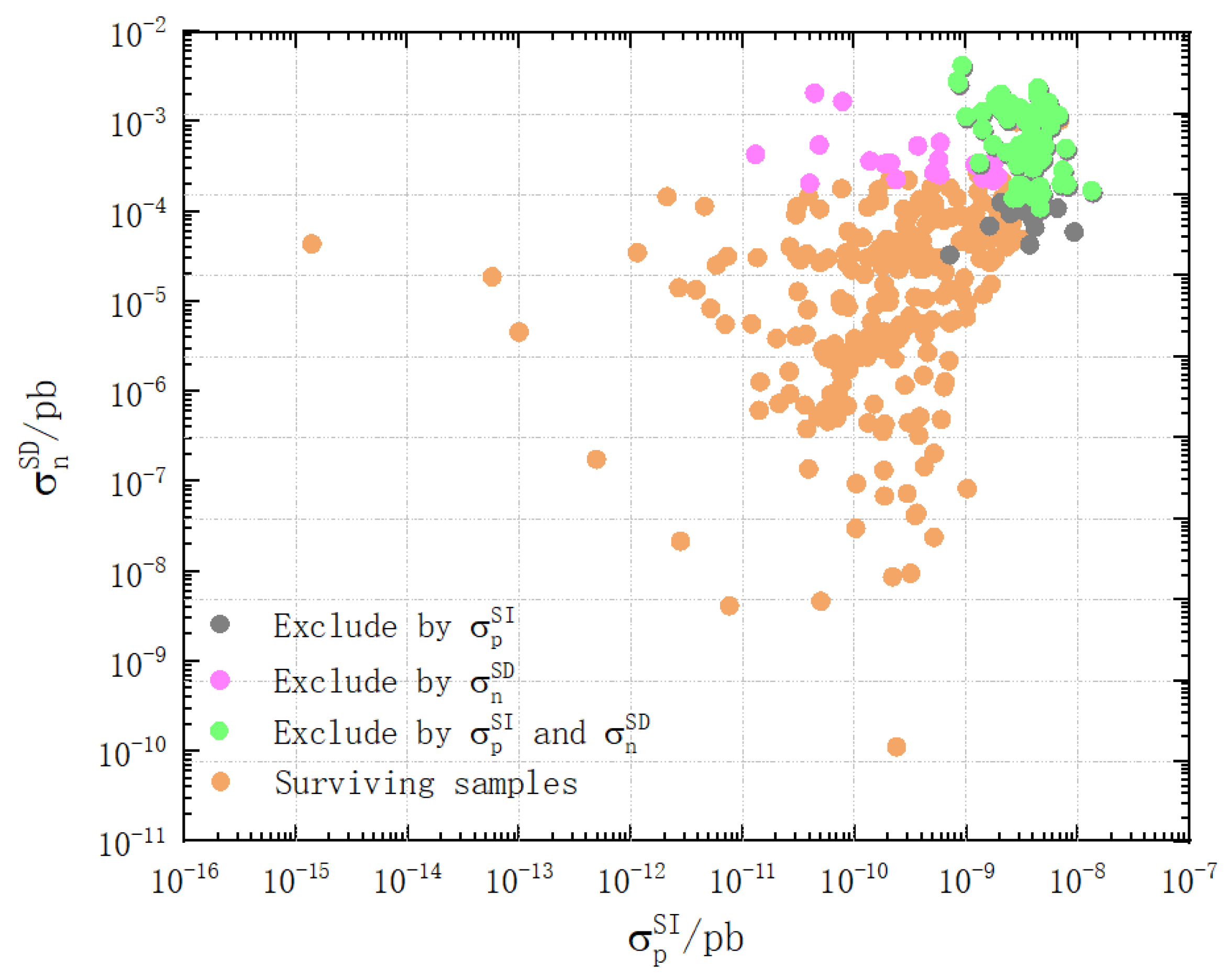
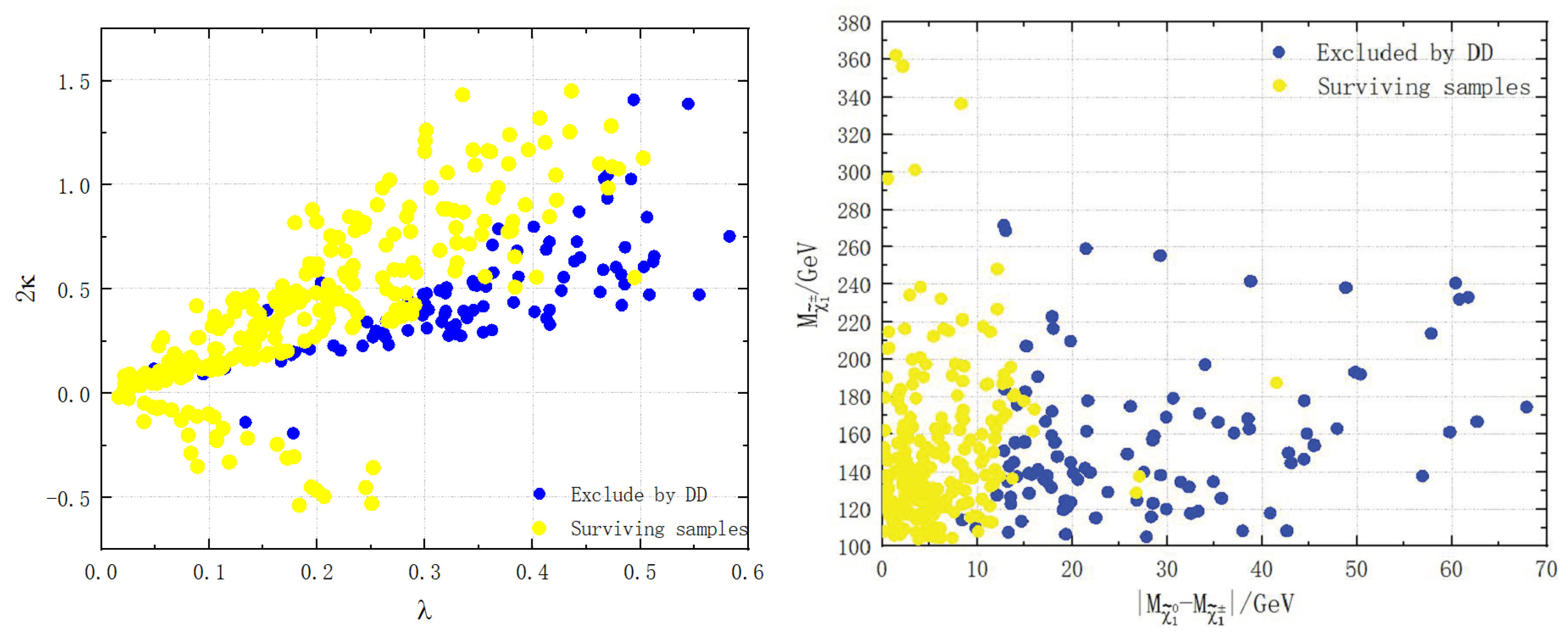
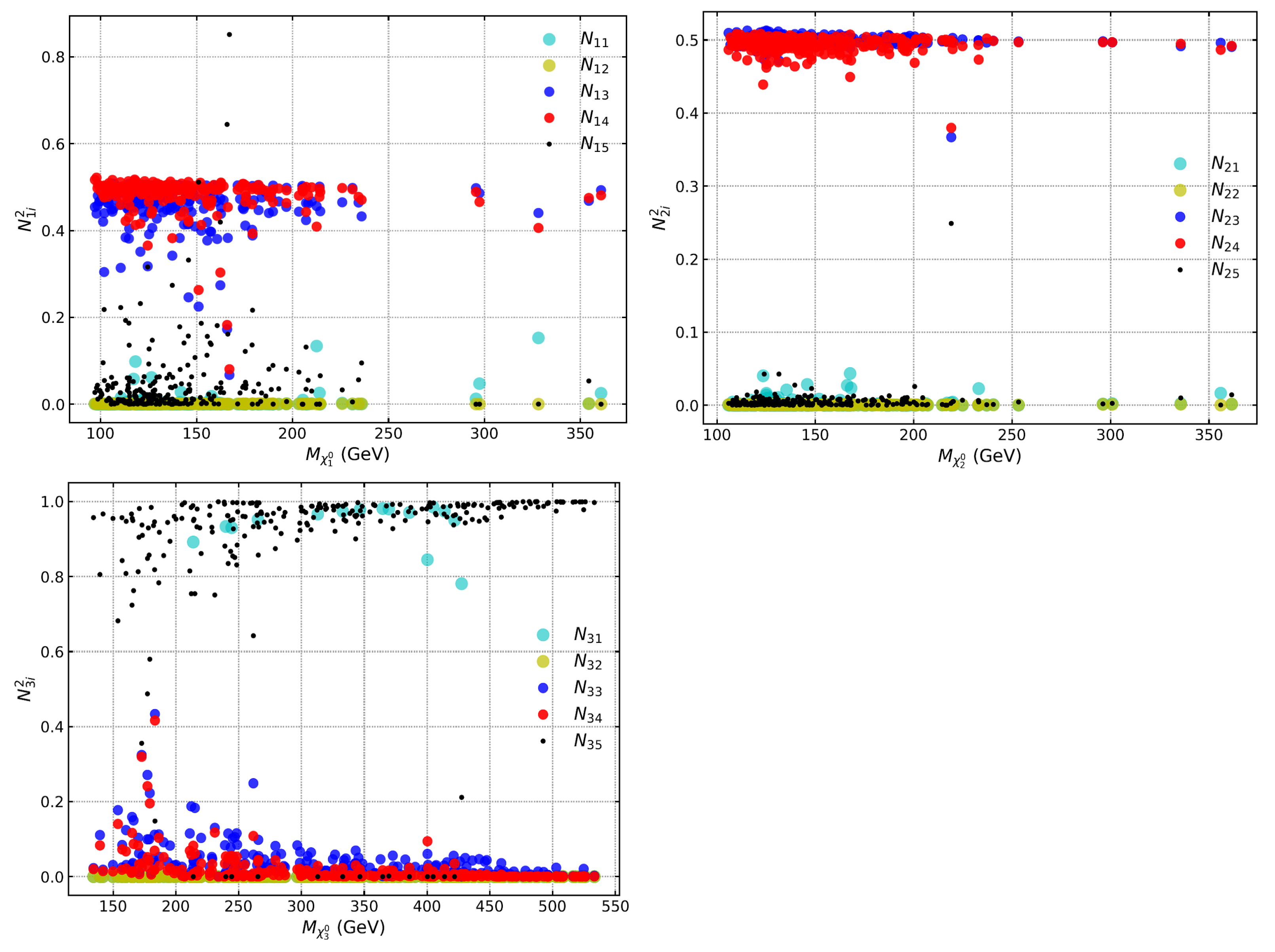
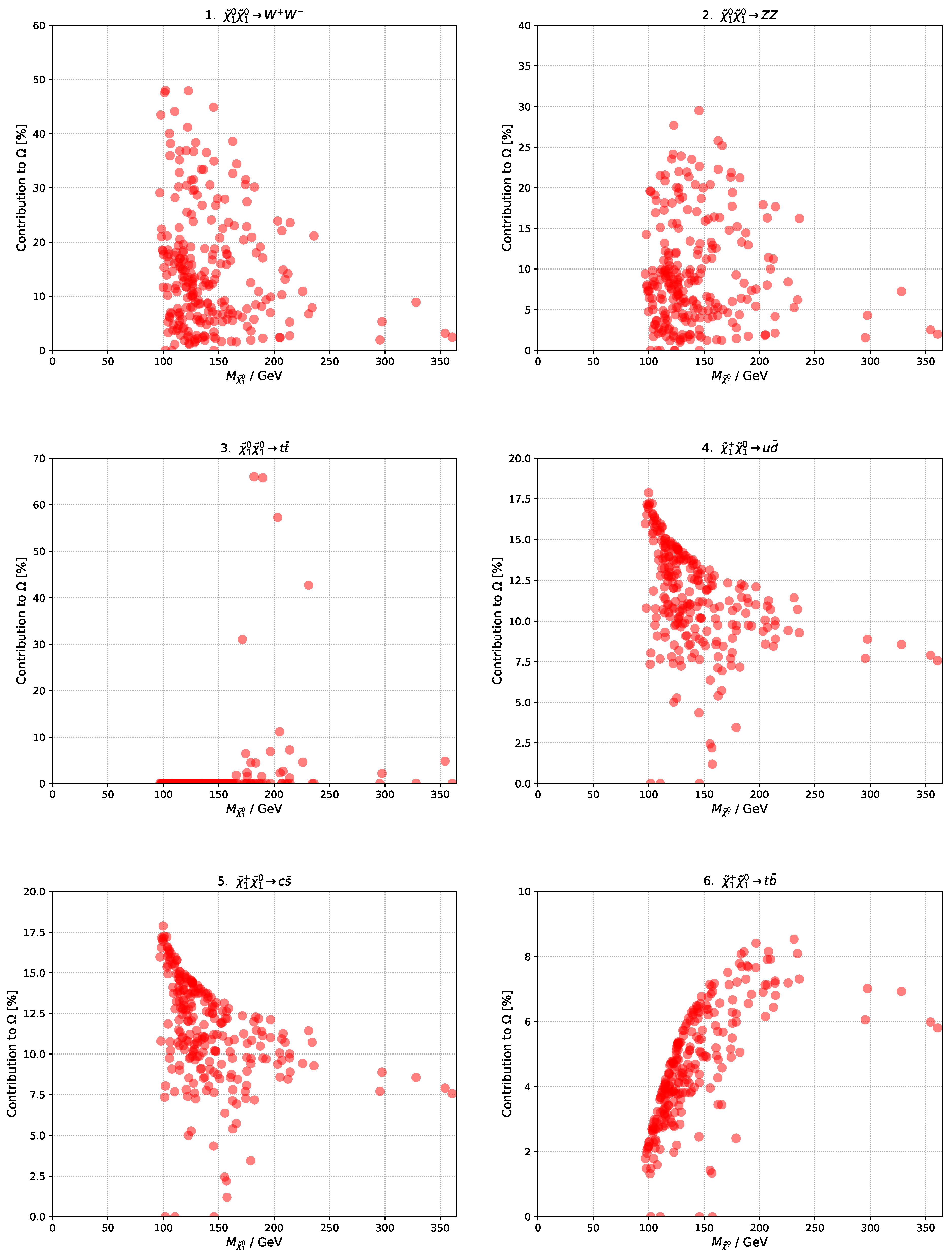
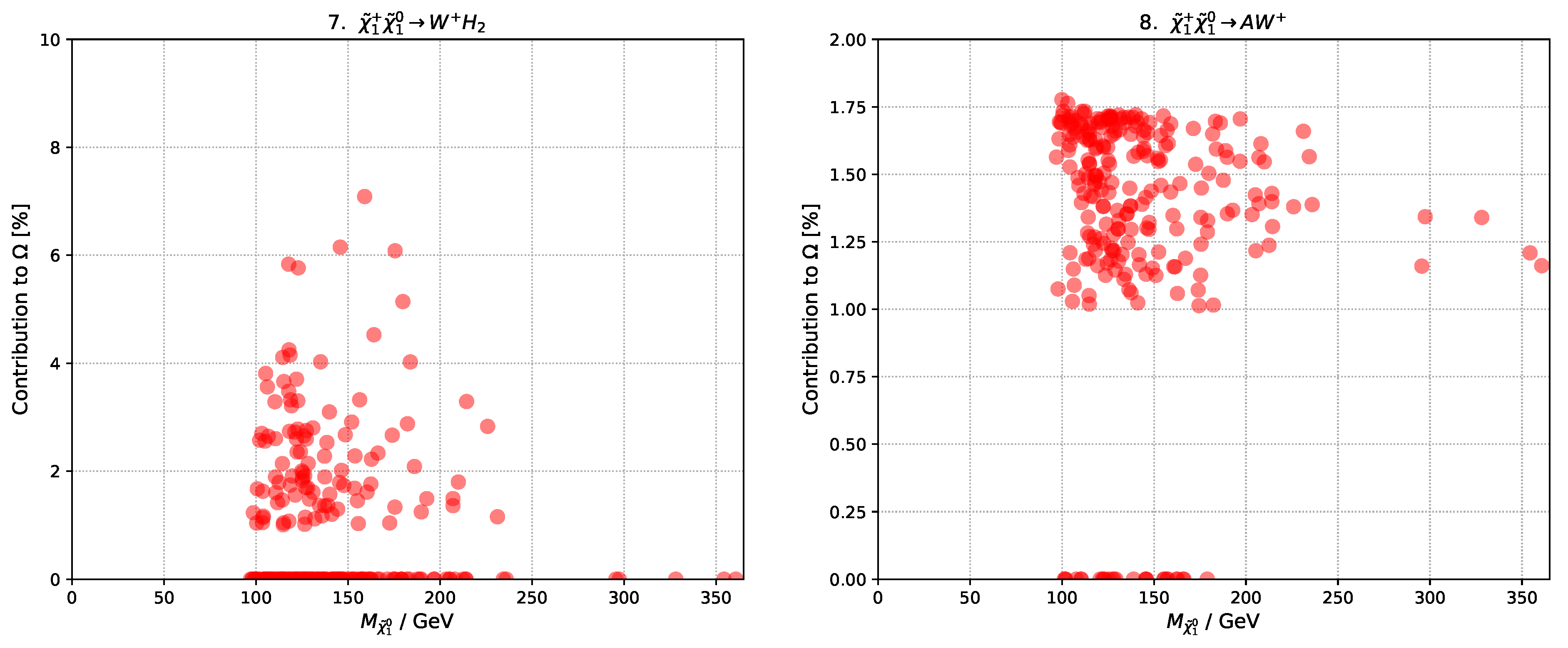
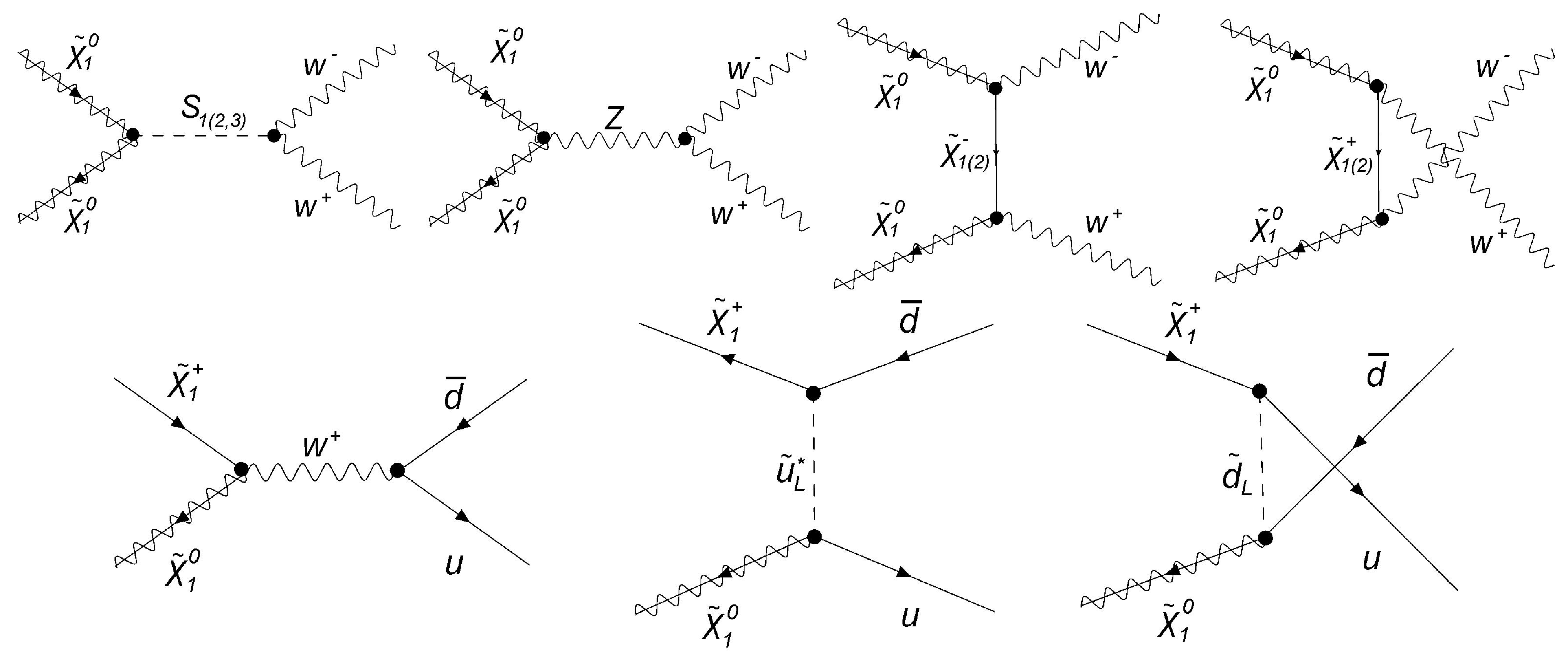
Disclaimer/Publisher’s Note: The statements, opinions and data contained in all publications are solely those of the individual author(s) and contributor(s) and not of MDPI and/or the editor(s). MDPI and/or the editor(s) disclaim responsibility for any injury to people or property resulting from any ideas, methods, instructions or products referred to in the content. |
© 2023 by the authors. Licensee MDPI, Basel, Switzerland. This article is an open access article distributed under the terms and conditions of the Creative Commons Attribution (CC BY) license (https://creativecommons.org/licenses/by/4.0/).
Share and Cite
Heng, Z.; Yang, S.; Li, X.; Shang, L. The Phenomenological Research on Higgs and Dark Matter in the Next-to-Minimal Supersymmetric Standard Model. Symmetry 2023, 15, 456. https://doi.org/10.3390/sym15020456
Heng Z, Yang S, Li X, Shang L. The Phenomenological Research on Higgs and Dark Matter in the Next-to-Minimal Supersymmetric Standard Model. Symmetry. 2023; 15(2):456. https://doi.org/10.3390/sym15020456
Chicago/Turabian StyleHeng, Zhaoxia, Shenshen Yang, Xingjuan Li, and Liangliang Shang. 2023. "The Phenomenological Research on Higgs and Dark Matter in the Next-to-Minimal Supersymmetric Standard Model" Symmetry 15, no. 2: 456. https://doi.org/10.3390/sym15020456
APA StyleHeng, Z., Yang, S., Li, X., & Shang, L. (2023). The Phenomenological Research on Higgs and Dark Matter in the Next-to-Minimal Supersymmetric Standard Model. Symmetry, 15(2), 456. https://doi.org/10.3390/sym15020456




